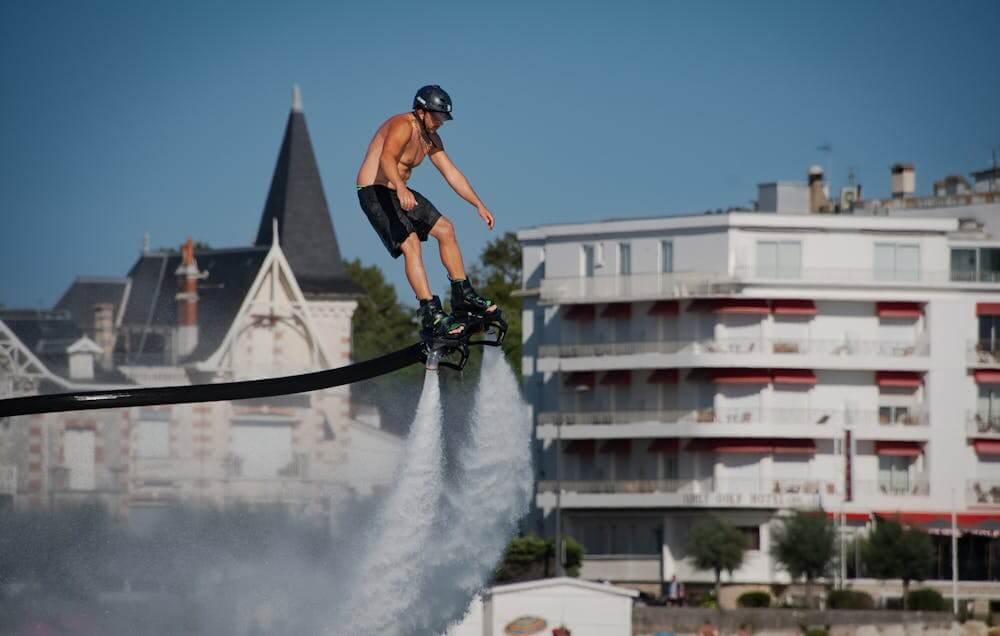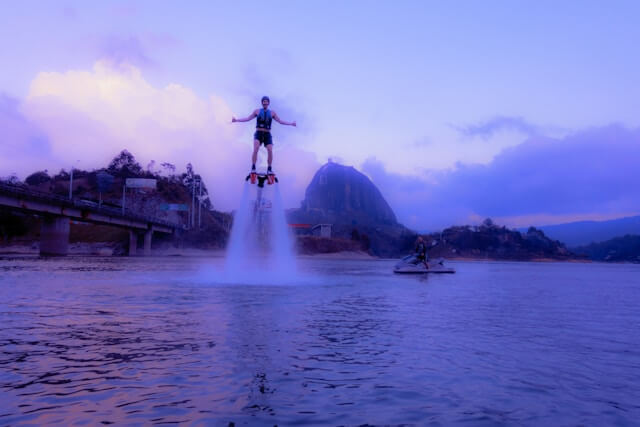Flyboarding is taking the water sports world by storm, offering an adrenaline-fueled experience like no other.

With the ability to propel riders into the air using water jets, flyboarding provides a unique and thrilling adventure for those seeking a new challenge on the water.
Whether you are a seasoned water sports enthusiast or a newcomer looking to try something different, flyboarding has something to offer for everyone.
One of the key benefits of flyboarding is the incredible sense of freedom and excitement it provides.
As you soar above the water, you can feel the rush of adrenaline and the thrill of defying gravity.
The feeling of weightlessness combined with the breathtaking views from above make flyboarding an experience like no other.
Additionally, flyboarding can also help improve balance, coordination, and core strength, making it not just a fun activity, but also a great workout.
One of the most unique features of flyboarding is the ability to perform acrobatic maneuvers and tricks while in the air.
From flips and spins to dives and twists, the possibilities are endless when it comes to showcasing your skills on a flyboard.
With practice and determination, you can master the art of flyboarding and impress onlookers with your gravity-defying stunts.
In the next part of this guide, we will delve into the equipment needed for flyboarding, including the flyboard itself, safety gear, and training tips.
We will also explore the best locations for flyboarding around the world, highlighting some of the most scenic and thrilling spots to try this exciting sport.
So stay tuned for more information on how to make the most of your flyboarding experience and take your water sports adventures to new heights.
Understand the Basics of Flyboarding
Before you dive into flyboarding, it’s essential to have a good understanding of the basics.
Flyboarding involves using a water-powered jetpack to propel yourself into the air and perform various tricks and stunts.
By familiarizing yourself with the equipment, safety measures, and proper techniques, you can ensure a successful and enjoyable experience.
Choose the Right Location
When it comes to flyboarding, the location plays a crucial role in your overall experience.
Make sure to choose a location with calm and clear waters, free from obstacles such as rocks or debris.
Additionally, consider factors such as wind conditions and water depth to ensure a safe and enjoyable flyboarding session.
Wear the Proper Gear
Safety should always be a top priority when flyboarding.
Make sure to wear the proper gear, including a helmet, life jacket, and wetsuit.
These essential pieces of equipment will not only protect you from potential injuries but also enhance your overall flyboarding experience.
Practice Proper Technique
Flyboarding requires a certain level of skill and technique to master.
Make sure to practice proper body positioning, balance, and control to stay stable in the air and perform tricks with ease.
Taking lessons from a certified instructor can help you improve your flyboarding skills and make the most of your experience.
Stay Safe and Respectful
While flyboarding can be an exhilarating experience, it’s crucial to prioritize safety and respect for others.
Always follow the rules and guidelines set by the flyboarding operator, and be mindful of other water users in the area.
By staying safe and respectful, you can enjoy flyboarding responsibly and without any incidents.
Pros of The Ultimate Guide to Flyboarding: Everything You Need to Know
Detailed Information:
This guide provides comprehensive information about flyboarding, covering everything from the basics to advanced techniques.
Readers can learn about the equipment, safety measures, and tips for mastering this thrilling water sport.
Step-by-Step Instructions:
The guide includes step-by-step instructions on how to flyboard, making it easy for beginners to understand the mechanics of the activity.
With clear explanations and visuals, readers can quickly grasp the concepts and start practicing on their own.
Expert Tips and Tricks:
In addition to basic information, the guide offers expert tips and tricks for enhancing flyboarding skills.
From proper posture to maneuvering techniques, readers can benefit from the insights shared by seasoned flyboarders.
Equipment Recommendations:
To help readers make informed decisions, the guide also provides recommendations on flyboarding equipment.
From choosing the right board to selecting safety gear, readers can find valuable suggestions for a safe and enjoyable flyboarding experience.
Cons of The Ultimate Guide to Flyboarding: Everything You Need to Know
Lack of In-depth Information:
The Ultimate Guide to Flyboarding may not provide detailed or comprehensive information on important aspects of flyboarding, leaving readers with unanswered questions.
Limited Scope:
The guide may not cover all the necessary topics related to flyboarding, making it difficult for beginners to fully understand the sport and its techniques.
Outdated Content:
With the rapid advancements in flyboarding technology and techniques, The Ultimate Guide to Flyboarding may contain outdated information that is no longer relevant or accurate.
Lack of Visual Aids:
Visual aids such as images, diagrams, or videos can greatly enhance the learning experience for readers, but The Ultimate Guide to Flyboarding may lack such visual content.
Biased Information:
The guide may be written from a biased perspective, promoting certain brands or products without providing an objective view of the flyboarding industry.
FAQs
1. What is Flyboarding and How Does It Work?
Flyboarding is a water sport that combines elements of jet skiing, wakeboarding, and snowboarding.
It involves standing on a board attached to a jet ski by a long hose, which uses water pressure to propel you into the air and allow you to perform aerial maneuvers.

The board is designed to provide traction and stability, and the jet ski provides the power to lift you up and control your movements in the air.
2. What Safety Precautions Should I Take When Flyboarding?
Safety is crucial when flyboarding.
Always wear proper safety equipment, including a helmet, bodysuit, and boots.
Follow instructions from your guide and maintain a safe distance from the jet ski.
Stay hydrated and take breaks as needed.
Additionally, use good judgment and common sense to ensure a safe and enjoyable experience.
3. Do I Need to Be Fit to Go Flyboarding?
Flyboarding can be physically demanding, requiring a good level of fitness and coordination.
However, it is not necessary to be extremely fit to participate.
With proper instruction and practice, anyone can learn to flyboard.
It is essential to listen to your body and stop if you feel tired or uncomfortable.
4. What Are the Age and Weight Requirements for Flyboarding?
Age and weight requirements for flyboarding vary depending on the operator and equipment used.
Generally, there are no specific age limits, but some operators may have age restrictions.
Weight limits are typically based on the flyboard’s capacity, and these vary from one operator to another.
It is essential to check with the operator before participating.
5. How Long Does a Flyboarding Session Typically Last?
The length of a flyboarding session can vary depending on the operator and the level of experience.
For beginners, a 30-minute session is often recommended to allow for proper instruction and practice.
More experienced riders may opt for longer sessions, up to 45 minutes or an hour.
It is essential to check with the operator before booking a session to determine the best duration for your needs.
By following these guidelines and tips, you can ensure a safe and enjoyable flyboarding experience.
Remember to always prioritize safety and follow instructions from your guide to maximize your time on the water.